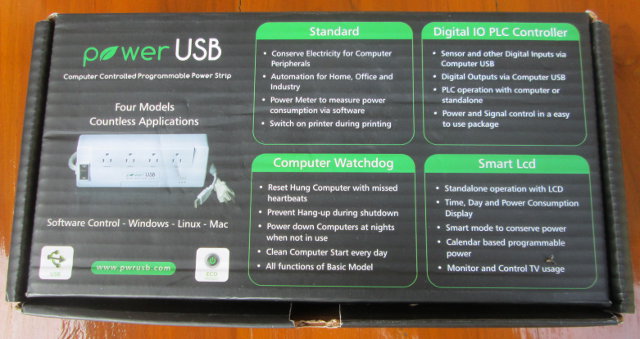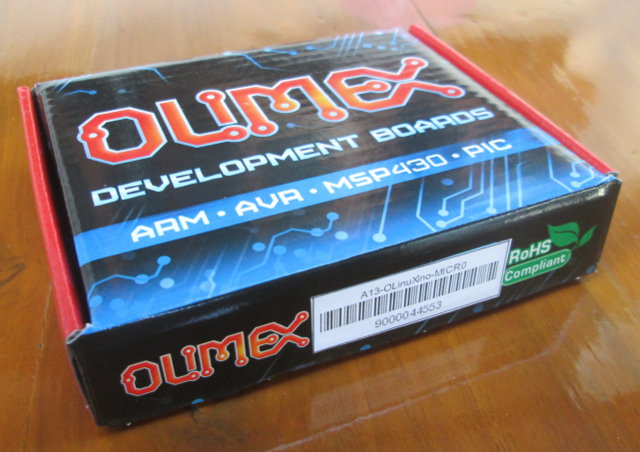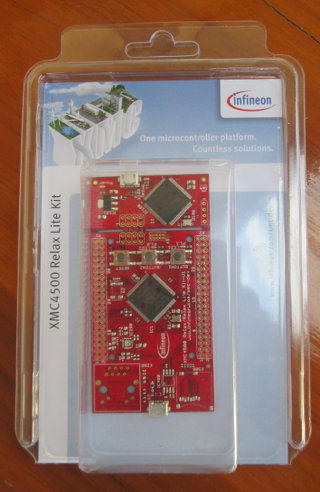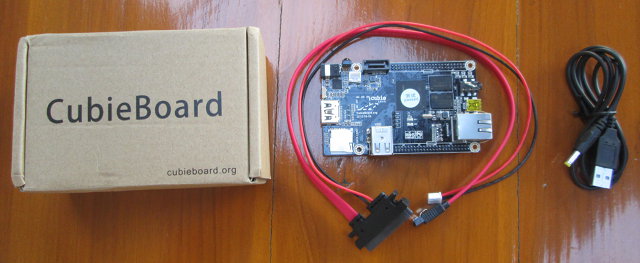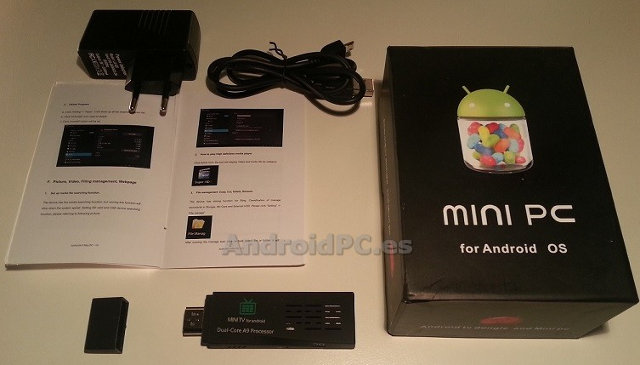PowerUSB power strips are four outlets power strips designed to help users save power by better understanding their devices power consumption, and automatizing tasks such as power on/off using timers, printer on/off controls, and more. One outlet is always on (for the main computer) and the 3 remaining outlets can be controlled via USB and the control software installed in a Linux, Mac or Windows x86 machine. The three of the four outlets are controlled through the software. Those power strips should allow lower electricity bills, and cover the cost of the strips ($69 to $129) within a few months. There are 4 models: PowerUSB Basic – $69.99 – The simplest model. You can control the 3 programmable outlets with on/off timers and keyboard shortcuts. PowerUSB Digital IO – $109.99 – This version adds 5 digital input/output lines for instrumentation and automation. The current model has 3 inputs and 2 […]
Olimex A13-OLinuXino-MICRO Development Board Unboxing And Review
Every Friday, Olimex organizes an online competition where they give away one of their board. They’ll ask a (usually simple) technical question on their twitter account at 22h00 (GMT+7), and all you have to do is to reply to their tweet with the correct answer within one hour. The winner is then selected randomly with random.org. There are usually 50 to 100 respondents so the odds are pretty good. I played a few times, and finally, I was lucky enough to win an A13-OLinuXino-MICRO development board at the beginning of December. I received it yesterday, after UPS took a whooping 15 days to deliver the board (Way to go UPS!). The board can be purchased on Olimex for 35 Euros plus shipping and taxes, or even lower if you order larger quantities. A13-OLinuXino-MICRO is a stripped down version of A13-OLinuXino-WIFI with the following specs: SoC – AllWinner A13 Cortex A8 […]
Running Ubuntu in Android with ODROID-X Development Board
I’ve had several people asking me about running Linux on Android in the last few months, but I did not look into it into details, because I thought we would just be able to run server apps. That is until Rohith left a comment on CNX Software Facebook timeline, that it’s possible to run Linux in Android, and access the user interface via VNC (sort of simple, but I did not think of it). You probably need at least 1GB of memory and a multi-core processor to run this sort of setup correctly, so I finally decided to give it a try by running Ubuntu 12.04 with Unity interface in ODROID-X development board. I mainly followed the instructions available at http://linuxonandroid.org/ and inside the Android app. Most of the steps I followed can also be replicated on other rooted Android hardware platforms. Apart from Ubuntu 10.04 & 12.04, you can […]
Getting Started with Infineon XMC4500 Relax Lite Kit and DAVE 3 IDE
Infineon Relax Lite Kit is a 10 Euros development kit based on Infineon XMC4500 Cortex M4 MCU with 160 KB SRAM and 1 MB flash, and featuring 2 USB OTG ports for debugging and powering up the board, 3 buttons (including reset), 2 LEDs, and 2 headers (through holes) giving access to the signals from the MCU such SPI, I2C, I2S, UART, CAN, ADC, DAC and PMW. The kit if available online via Hitec, but unless you live in Germany, this is not an interesting option, as international shipping costs over 100 Euros. So you’d better check local distributors in your country. The package only comes with the board, and you’ll need a USB to microUSB to power the board. To get started, simply connect the board via the USB cable to one of the USB OTG connectors, and to a Windows PC. The power LED (green) should lit up, […]
Cubieboard Unboxing and Quick Start Guide
I’ve received another cool board this week with the Cubieboard development board. As a quick reminder, the Cubieboard is the only proper low cost AllWinner A10 development board available, and comes with 512MB/1GB RAM, 4GB NAND Flash, 10/100 MBit Ethernet, HDMI output, 2x USB Host port, 1x USB OTG port, a microSD socket, a SATA interface, an IR sensor and 2 headers to access extra pins such as GPIOs, I2C, SPI,VGA pins, CVBS pins etc… CubieTech had a successful Indiegogo campaign where the 1GB board was available for $59 including worldwide shipping (and as low as $19 for early birds), and you can now buy it from resellers. [Update: It’s now available with several cables, USB to TTL debug board, and an enclosure for $80 on dx.com] Cubieboard Unboxing The board comes with a SATA cable and a USB cable for power. There’s no power supply so you’ll need you […]
Droid Stick A2 mini-PC Unboxing
Droid Stick A2 is an HDMI TV Stick based on AMLogic AML8726-MX dual core Cortex A9 processor, and together with HI-802 (aka GK802) mini-PC based on Freescale i.MX6Q, is the most likely platform to get proper Linux support, as AMLogic AML8726-MX source code is somewhat open, and video playback in Linux is supported in the older AML8726-M1 processor (Cf. XBMC Linux in Pivos STB). Kimdecent sent me a sample for evaluation, but as the Android firmware is not really ready for prime-time at this time, I’ll just show some pictures of the device, as well as the user interface, and will review the device once a firmware update is available. Since this is still a sample, I received the device in a white box with the Droid Stick A2, a mini USB to USB cable, a small 5.2V/1A power supply and a plug adapter. There are plenty of ventilation hole […]
ZOPO ZP900S Leader Smartphone Unboxing and Review
I’ve just received ZOPO ZP900S smartphone from Pandawill by Fedex. This phablet features a 5.3″ display, MediaTek MTK6577 dual core cortex A9 processor with 512 MB RAM, 4GB flash and runs Android 4.0 (upgradable to Android 4.1 once the firmware is released). This is the lite version of ZOPO ZP900 which comes with 1GB RAM. Both devices look like low cost versions of the Samsung Galaxy Note as you can see from the comparison table below between ZOPO ZP900S, ZOPO ZP900 and Samsung Galaxy Note N7000. ZOPO ZP900S & ZP900 Specifications ZOPO ZP900S Leader ZOPO ZP900 Leader Samsung Galaxy Note CPU Mediatek MTK6577 @ 1GHz Samsung Exynos 4210 @ 1.4 GHz GPU POWERVR SGX531T ARM Mali-400MP RAM 512 MB 1GB 1GB Storage 4 GB Flash + microSD 16GB/32GB Flash + microSD Display 5.3″ IPS 960×540 (qHD) 5.3″ super AMOLED 1280×800 Camera 8MP Rear, 2MP Front 8MP Rear, 2MP Front Wi-Fi […]
Kimdecent T21 mini PC Unboxing and Review
Androidpc.es has written a review for the low cost ($49) Kimdecent T21 dual core mini PC in Spanish, and I’ll provide a summary of the review in English below. Kimdecent T21 Unboxing Kimdecent T21 is an Android 4.1 HDMI TV Stick powered by Nufront NS115 dual core Cortex A9 processor. Check out my earlier post about Kimdecent T21 for specifications. The package comes with T21 mini PC, a power adapter with USB to micro USB cable, and a user manual in English. You can also watch T21 Unboxing Video on YouTube. Kimdecent T21 User Interface & System Overview The user interface is a standard Android screen, albeit with power and volume buttons in the Status Bar. I don’t really find this interface very suitable for the TV, but you can always install your own launcher such as Android TV Launcher (apk), or other launcher apps available on Google Play. Beside […]


